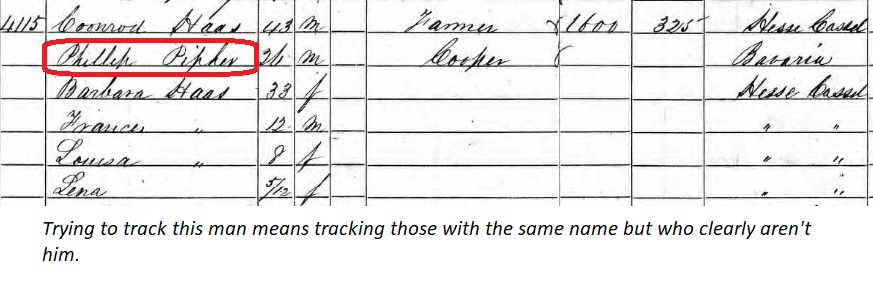I’m trying to find a man enumerated in an 1860 census as Philip Pipher. He may be the brother of Barbara Haase who is enumerated in Hancock County, Illinois, with her husband Conrad. Philip’s last name may actually be Siefert or some rendition of it as that was Barbara’s maiden name.

The places of birth for these individuals in this 1860 enumeration are to be taken with a grain of salt. The children 12 and under all are known to have been born in Illinois, so it’s possible that other places of birth are incorrect as well.
My attempts to find him needs to include an eliminated list of individuals who are named Philip Pipher/Siefert (or reasonable variants) and can’t be him. Creating this list requires me to use what I know about this Philip as a guide to elimination. He’s living in a certain spot in 1860 and is listed with a specific place of birth and an occupation. This means he’s probably not a man named Philip Siefert living in Chicago in 1860 as a lawyer. He’s probably not a 25 year old living in Kansas in 1875. My chart also needs to include why I’ve eliminated that Philip as being this person. Examples might include any detail that’s significantly inconsistent with what’s stated about this individual–admitting that any fact could be incorrect.
If I keep track of the ones I have eliminated and why, then I don’t waste time researching them again. Or if what I “know” about Philip changes, I can go back and review them and see if they still don’t match. But if I don’t track these failed-to-be-my-Philips, I can’t do that.
And I need to remember that this Philip may not even be a relative to the Haases at all. But I won’t know if I don’t look and track those searches and results effectively.







3 Responses
Thank you for this post on being mindful of elimanting the people who could not be the person for whom you are looking. Will you please share the format of the log that you use to keep track of the non-candidates? Thanx! Bill
I can do that–I’m working on a post with some specific suggestions.
[…] Michael John Neill with another great Genealogy tip of the day Tracking the Wrong Ones […]